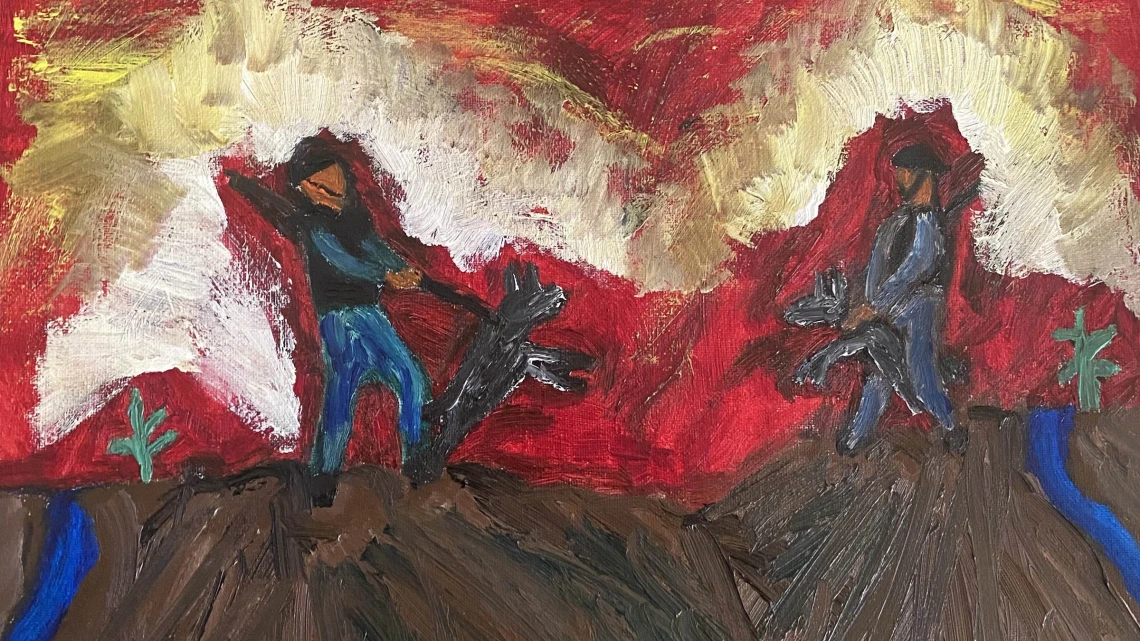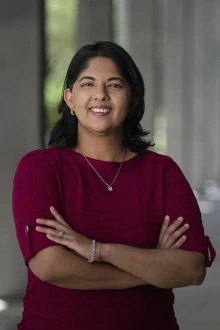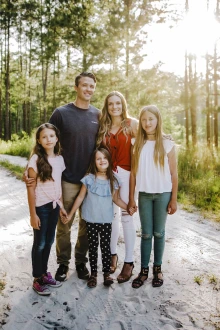Public Health Students Use Art To Express Climate Change Challenges
In response to the health threats posed by climate change, Dr. Mona Arora’s course guided students to express their frustration and determination through artworks.

Ryan Sitton, MPH, created this painting to represent the challenges of climate change as part of EHS 525 Global to Local: Environmental Change and Human Health, a course Mona Arora, PhD, MSPH, created to engage the complex emotions around climate change.
Often when students learn about the many devastating effects of climate change on plants, animals, ecosystems and humans, they experience stress and despair because of the number of crises needing solutions. It is not uncommon for students to feel helpless and fearful when faced with the real consequences from climate change.

Mona Arora, PhD, MSPH
“Evidence is building that shows the mental health ramifications of sustained exposure to the climate crisis in the form of anxiety and grief. New terms have emerged such as ‘ecoanxiety’ and ‘ecogrief’ to describe this new human experience,” Dr. Arora said. “Too often when we teach climate change, we neglect to acknowledge the stress that students experience when they hear about one doom-and-gloom situation after another.”
Dr. Arora recruited Ellen McMahon, MFA, MS, the associate dean for research in the UArizona College of Fine Arts, as a guest lecturer for the course. In her lecture, “Climate, Art and Resilience,” McMahon explored how art has been used as a tool to engage, communicate, advocate and express emotions and determination related to environmental crises linked to climate change. For one of the assignments, students were guided to create an artwork that expressed their feelings and perceptions on climate change.
“Unlike most forms of climate communication, art has its origins in subjective experience,” Dr. McMahon said. “Art educates our emotions, improving our ability to know how we feel and feel what we know. This in turn heightens awareness of our social bonds and connections to everything, leading us to make better choices about how to live in a turbulent world.”

Ryan Sitton, MPH, with his wife and three daughters
“It changed my understanding of climate change and public health by providing a neutral learning platform, a space where we could really explore the topic free from personal opinion and associated politics,” Sitton said. “It was refreshing to step away from the doom and gloom that is often associated with climate change and to get a better understanding of how public health leaders can play a pivotal role to implement positive changes.”
Although he had not completed an art assignment for a course before, Sitton said he found the process much more impactful than he anticipated. His painting portrays a dark future where people compete for resources.
“In my painting, in the context of climate change, the soldiers represent different countries and communities that are guarding their finite resources. Hopefully this is not the actual future, but I see it as a cause for concern and a very likely scenario,” he said.
Loren Halili also graduated in May with a master’s in public health with an environmental and occupational health concentration. The course expanded her understanding of how climate change impacts human health in many different ways and the importance of public health strategies to mitigate those health risks. For her climate change artwork, she wrote a poem:
The world around me,
Is not what it used to be
The air is filled with pollutants made of dust and debris
My little brother with asthma says it’s becoming harder to breath
The rain is never ending, falling harder and faster
My cousins live in the Philippines, where Typhoons have created disaster
Fires rip through terrain, that’s dry as a bone
My family in Oregon calls me on the phone.
They say, “The sky is red! There are flames anywhere I look!”
Moral of the story,
Climate change is real, and isn’t some made-up book
If a tree falls in a forest and no one is around,
How do we know if it even made a sound?
Who cares if people look at us strange?
We all need to speak up about climate change
Some say “there are more important issues that are worth a crown”
So, do we just sit here and watch our world burn down?
The topic is already met with a so much disagree
But differing opinions shouldn’t stop us from spilling the tea
From tornadoes in Tennessee
To diminishing marine life undersea
All I know is,
that the world around me
Is not what it used to be
“I have family all around the world that have been affected by climate change in different ways. I hope my artwork gives a raw experience of the impacts of climate change,” Halili said. “I wrote my poem from a first-person perspective, and I hope it shows that anyone’s family could go through these struggles. I feel that adding personal experience will help shift perspectives for those who may not have experienced climate change directly.”
Halili is now working for the Center for Rural Health as program coordinator for Advancing Health Equity, Addressing Disparities (AHEAD AZ), a COVID-19 health disparities program.
Both Dr. Arora and McMahon said they were impressed by the response of the students in the course and were inspired by the artworks they created. The complex impacts of climate change will reshape our world and place many communities in jeopardy, and the intersection of public health and artistic creation can help us find a path forward, to heal, to process, and to prepare.
The course will be offered again in Spring 2023 for both undergraduate and graduate students.
A version of this story was originally published by the College of Public Health.

